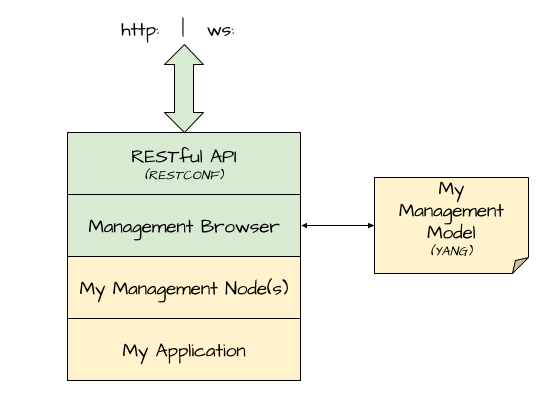C2Stack let's you add management capability to any application written in the Go programming language. Manage configuration, metrics, RPCs and events using a RESTful API with web sockets for updates.
Standards : YANG RFC6020, RESTCONF (RFC TBD)
Download the source into your project
go get -d -u github.com/ctstack/c2g/...
- No dependencies beyond Go Standard Library
- No code generation or code annotations required
- Simple and flexible
- Includes tools to generate documentation. examples: car diagram, car api
Licensed under BSD-3-Clause license.
You do not need to write code that deals with configuration files.
type car struct {
frontSeat *seat
owner string
...
}
type seat struct {
...
}Using your knowledge of your application, you probably have an idea of what data you want configurable, what metrics you want available, what events/alerts you want to communicate and what internal functions you want to make available. Write a YANG file capturing your model.
model car {
namespace "";
prefix "";
container frontSeat {
description "Front seat of the cat";
/* more definition about the front seat ... */
}
leaf owner {
description "Owner of the car";
type string;
}
}
Based on your model, you need to write node handlers that map your model to your application.
import "github.com/c2stack/c2g/node"
func carNode(car *Car) node.Node {
return &node.MyNode{
// Navigation to other parts of your application based on your model
OnSelect : func(r node.ContainerRequest) (node.Node, error) {
switch r.Meta.GetIdent() {
case "frontSeat" :
if r.New {
// New is optional, don't implement if your car must have seats
car.frontSeat = &carSeat{}
}
if car.frontSeat != nil {
return seatNode(car.frontSeat)
}
}
return nil, nil
}
// Read/Write fields.
OnField : func(r node.FieldRequest, hnd *node.ValueHandle) error {
switch r.Meta.GetIdent() {
// node package has handlers that use reflection. Here we'll code this
// by hand.
case "owner":
if r.Write {
// optional : car is changing owners.
car.owner = hnd.Val.Str
} if r.Read {
// who is the car owner
hnd.Val = &node.Value{Str:car.owner}
}
}
return nil
}
// For RPCS implement OnAction
// For Events implement OnNotify
}
}import (
"github.com/c2stack/c2g/restconf"
"github.com/c2stack/c2g/meta/yang"
"github.com/c2stack/c2g/node"
)
func main() {
// Step 1 - Your app
car := &Car{}
// Step 2 - Load yang file, hint: leave off .yang file extension
model := yang.RequireModule(yang.YangPath(), "car")
// Step 3 - Node handler
data := carNode(car)
// Step 4 part a.) - Connecting everthing together. you can use browser object as a
// very powerful way to interact with your application outside the REST api
bwsr := node.NewBrowser(model, data)
// Step 4 part b.) - Start RESTful server
rc := restconf.NewService(yang.YangPath(), bwsr)
rc.Port = ":8080"
rc.Listen()
// To run
// YANGPATH=path/to/yang/file go run this_file_name.go
// To test
// curl http://localhost:8080/restconf/
}- Car Application - Complete application that manages a car and has web-based user interface.
- Code Examples - Mostly examples on node handlers.
- Example YANG files - Used internally by C2Stack
- More example YANG files - From openconfig.net project
